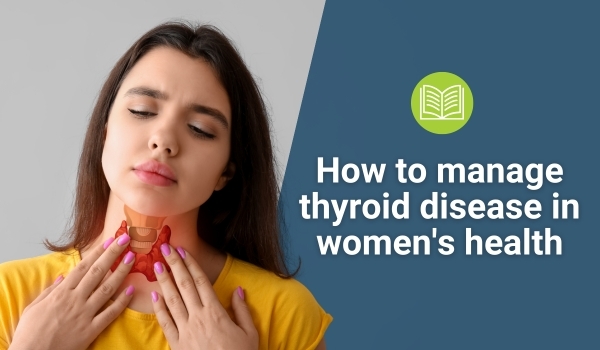Managing hormonal imbalance in women's health
Read more about how to investigate and manage common causes of hormonal imbalances in women's health, from PCOS and thyroid disease to menopause and POI.
.jpg)
HealthCert Education
Hormone imbalances are a common presentation in general practice among women of all ages and life stages. The spectrum is broad, encompassing menstrual disorders, thyroid disease, perimenopausal changes, premature ovarian insufficiency (POI), and metabolic dysfunction.
Hormone imbalance
Hormone imbalance usually refers to excess or deficiency in one or more hormones, disrupting normal physiology and function. In women, the most frequent presentations include reproductive, thyroid and metabolic hormone imbalance.
Causes
Common causes include polycystic ovary syndrome (PCOS), perimenopause and menopause, thyroid dysfunction (hypothyroidism and hyperthyroidism), and premature ovarian insufficiency (POI).
Presentation
Women may present with symptoms directly attributable to hormonal disturbance or may present with a perceived hormone imbalance. It is therefore important to clarify specific symptomatology and underlying concerns.
Symptoms can be varied and non-specific, including menstrual changes, fatigue, weight change, mood disturbance, acne and hirsutism. A focused history should include menstrual pattern, medication use (including contraception), fertility desires and psychosocial factors. Red flag symptoms, which may prompt urgent investigation, such as galactorrhoea, rapid virilisation or symptoms of thyroid storm or adrenal insufficiency, should also be specifically screened for.
Investigations
Investigations should be guided by the clinical picture. For menstrual irregularity or fertility concerns, first-line tests include a pregnancy test, serum follicle-stimulating hormone (FSH), luteinising hormone (LH), prolactin and thyroid-stimulating hormone (TSH). For suspected PCOS, total and free testosterone, sex hormone binding globulin (SHBG), and metabolic screening (e.g. fasting glucose, HbA1c and lipid profile) are recommended. In perimenopausal women over 40, fluctuating FSH and oestradiol can make hormone tests unreliable, and clinical history and symptomatology remain the most valuable diagnostic tools in women over 40. Persistently elevated FSH and low oestradiol in a woman under 40 may indicate POI. Thyroid function tests should be performed in women presenting with fatigue, weight change or menstrual disturbance.
In some cases, imaging may be appropriate – such as pelvic ultrasound for suspected PCOS or ovarian pathology, or a pituitary MRI for suspected hyperprolactinaemia.
Management
Management depends on the underlying diagnosis, symptom severity, reproductive goals and patient preference. Lifestyle interventions underpin the management of many hormonal imbalances. Regular exercise, balanced nutrition, adequate sleep and weight optimisation all promote hormonal health and metabolic health.
Pharmacological management is guided by the cause. For women with PCOS, combined hormonal contraception, metformin or anti-androgens (e.g. spironolactone) may be appropriate. For menopause, perimenopause and POI, hormone replacement therapy (HRT) remains first-line therapy for eligible women with vasomotor and/or urogenital symptoms. Where HRT is contraindicated, alternative therapies include selective serotonin reuptake inhibitors or other non-hormonal agents. In POI, HRT is recommended to support bone and cardiovascular health. Hypothyroidism is treated with levothyroxine, while hyperthyroidism management depends on the underlying aetiology.
Referral
For some women with hormone imbalance, referral to endocrinology or gynaecology should be considered, particularly where there is diagnostic uncertainty, treatment-resistant symptoms, suspected pituitary or adrenal pathology or complex fertility concerns.
Effective management of hormonal imbalance in women relies on a nuanced history, appropriate investigations, and a personalised, evidence-based management plan delivered within a holistic framework of primary care.
- Dr Samantha Miller, MBChB
Next steps in your learning journey
🎓 Women's Health Certificate Courses
Our university-assured, structured pathway to elevate your knowledge in women's health. ➡️ Explore full program >
🎓 Micro-Courses in Women's Health
Explore short, bite-sized CPD modules in focused topics in women's health. Complete in less than 10 hours! ➡️ Browse Micro-Courses >
🎓 HealthCert 365 subscription
Prefer flexible learning across many topics? Access 4,000+ CPD hours on-demand with HealthCert 365 — any topic, anytime, for one flat annual fee. ➡️ Discover HealthCert 365 >
Explore more educational content in Women's Health.
CPD self-submission
You can self-record CPD for this blog. If you consume educational content on this blog, you can Quick Log CPD hours with the RACGP/ACRRM via the usual self-submission process. You will be asked to reflect on what you have learned, and you will require supporting evidence such as a screenshot. For more information, view the: RACGP CPD guide | ACRRM CPD guide
References
- National Institute for Clinical Excellence (NICE)(2023). Thyroid disease: assessment and management. https://www.nice.org.uk/guidance/ng145
- BMJ Best Practice (2024). Hypothyroidism and hyperthyroidism. https://bestpractice.bmj.com
- The Royal Australian College of General Practitioners (2021). Thyroid disease: Using diagnostic tools effectively. https://www1.racgp.org.au/ajgp/2021/january-february/thyroid-disease-using-diagnostic-tools-effectively
- Australian Family Physician (2017). Premature ovarian insufficiency in general practice: Meeting the needs of women. https://www.racgp.org.au/afp/2017/june/premature-ovarian-insufficiency-in-general-practic
- Department of Health, State Government of Victoria, Australia. Better Health Channel: Polycystic Ovarian Syndrome. https://www.betterhealth.vic.gov.au/health/conditionsandtreatments/polycystic-ovarian-syndrome-pcos
- BMJ Best Practice (2020). Polycystic Ovary Syndrome. https://bestpractice.bmj.com/topics/en-gb/141
- BMJ Best Practice (2020). Abnormal Uterine Bleeding. https://bestpractice.bmj.com/topics/en-gb/658
- Monash University (2018). International evidence-based guideline for the assessment and management of polycystic ovary syndrome. https://www.monash.edu/__data/assets/pdf_file/0004/1412644/PCOS_Evidence-Based-Guidelines_20181009.pdf
- Department of Health, State Government of Victoria, Australia. Better Health Channel: Menopause. https://www.betterhealth.vic.gov.au/health/conditionsandtreatments/menopause
- National Institute for Health and Care Excellence (2015). Menopause: diagnosis and management. https://www.nice.org.uk/guidance/ng23/resources/menopause-diagnosis-and-management-pdf-1837330217413

 1800 867 1390
1800 867 1390
-1.jpg)
.jpg)



